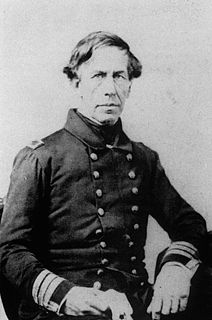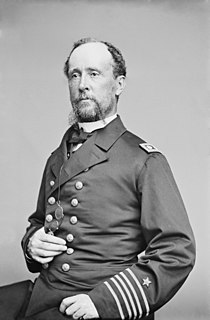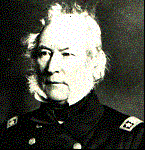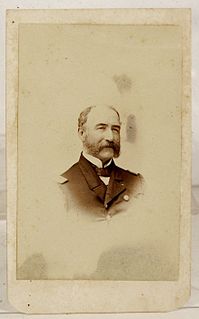Related Research Articles

USS Vincennes (1826) was a 703-ton Boston-class sloop of war in the United States Navy from 1826 to 1865. During her service, Vincennes patrolled the Pacific, explored the Antarctic, and blockaded the Confederate Gulf coast in the Civil War. Named for the Revolutionary War Battle of Vincennes, she was the first U.S. warship to circumnavigate the globe.

Charles Wilkes was an American naval officer, ship's captain, and explorer. He led the United States Exploring Expedition, 1838-1842. His behavior led to two convictions by court-martial, one stemming from the massacre of almost 80 Fijians on Malolo in 1840. During the American Civil War (1861–1865) he commanded USS San Jacinto during the Trent Affair, where he stopped a Royal Mail Ship and removed two British subjects, which almost led to war between the US and the UK.

The first USS Essex of the United States Navy was a 36-gun or 32-gun sailing frigate that participated in the Quasi-War with France, the First Barbary War, and in the War of 1812. The British captured her in 1814 and she then served as HMS Essex until sold at public auction on 6 June 1837.

The third USS Hornet was a brig-rigged sloop-of-war in the United States Navy. During the War of 1812, she was the first U.S. Navy ship to capture a British privateer.

Commodore Josiah Tattnall, Jr. was an officer in the United States Navy during the War of 1812, the Second Barbary War and the Mexican–American War. He later served in the Confederate Navy during the American Civil War.
The second USS Ontario was a three-masted, wooden-hulled sloop of war in the United States Navy, bearing 16 guns, and saw service during and following the years of the War of 1812 and in the Second Barbary War. Ontario was built by Thomas Kemp, Baltimore, Maryland, in 1813; blockaded in Chesapeake Bay through the War of 1812; and sailed from New York for the Mediterranean on 20 May 1815, Master Commandant Jesse D. Elliott in command.

Louis Malesherbes Goldsborough was a rear admiral in the United States Navy during the American Civil War. He held several sea commands during the Civil War, including that of the North Atlantic Blockading Squadron. He was also noted for contributions to nautical scientific research.

Rear Admiral Christopher Raymond Perry Rodgers was an officer in the United States Navy. He served in the Mexican–American War, the American Civil War, as Superintendent of the Naval Academy, President of the United States Naval Institute, and Commander-in-Chief of the Pacific Squadron.
Commodore John Downes was an officer in the United States Navy, whose service covered the first half of the 19th century.

William Branford Shubrick was an officer in the United States Navy. His active-duty career extended from 1806 to 1861, including service in the War of 1812 and the Mexican–American War; he was placed on the retired list in the early months of the Civil War.

Captain William Levereth Hudson, USN was a United States Navy officer in the first half of the 19th century.

HMS Pelorus was an 18-gun Cruizer-class brig-sloop of the British Royal Navy. She was built in Itchenor, England and launched on 25 June 1808. She saw action in the Napoleonic Wars and in the War of 1812. On anti-slavery patrol off West Africa, she captured four slavers and freed some 1350 slaves. She charted parts of Australia and New Zealand and participated in the First Opium War (1839–1842) before becoming a merchantman and wrecking in 1844 while transporting opium to China.

Admiral of the Fleet Sir William Parker, 1st Baronet, GCB, was a Royal Navy officer. As a captain's servant he took part in the Battle of The Glorious First of June in June 1794 during the French Revolutionary Wars and, as a captain, he participated in the capture of the French ships Marengo and Belle Poule at the Action of 13 March 1806 during the Napoleonic Wars. He was detached on an independent command on the Tagus in September 1831 with a mission to protect British interests during the Portuguese Civil War. As Commander-in-chief of the East Indies and China Station, he provided naval support at various actions between 1841 and 1842 during the First Opium War. Appointed Commander-in-Chief, Mediterranean Fleet in February 1845, he was briefly First Naval Lord in the First Russell ministry from 13 July 1846 to 24 July 1846 but gave up the role due to ill health before returning to his command with the Mediterranean Fleet.

Admiral Sir Anthony Hiley Hoskins, was a Royal Navy officer. As a junior officer, he took part in the Cape Frontier War of 1851 and then saw action at the Battle of Canton in December 1857 and the Battle of Taku Forts in May 1858 during Second Opium War. Once promoted to flag officer rank, he acted as Second-in-Command of the Fleet at the bombardment of Alexandria in July 1882 during the Anglo-Egyptian War. He went on to be First Naval Lord in September 1891 but in that role took a relaxed view of the size of the Fleet and did not see the need for a large shipbuilding effort on the scale envisaged by some of his colleagues, such as Admiral Sir Frederick Richards and Admiral Sir John Fisher who were concerned about French and German naval expansion.

Admiral Sir Compton Edward Domvile, was a distinguished Royal Navy officer in the Edwardian era.

George Campbell Read was a United States Naval Officer who served on Old Ironsides during the War of 1812 and commanded vessels in actions off the Barbary Coast and India. Read eventually rose to the rank of rear admiral.
Rear Admiral Sir Francis Augustus Collier, CB, KCH was a senior officer of the British Royal Navy during the early nineteenth century. Born into a naval family, Collier served in the French Revolutionary Wars and fought at the Battle of the Nile on Horatio Nelson's flagship. During the Napoleonic Wars he was engaged in campaigns in the West Indies and in 1819 he commanded an operation against pirates in the Persian Gulf. He remained in service for the next thirty years, holding several commands before his death in 1849 as commander of the China Squadron at Hong Kong.

HMS Scylla was an 18-gun Cruizer-class brig-sloop of the Royal Navy. The first to bear the name Scylla, she was launched in 1809 and broken up in 1846.
HMS Canso was the American letter of marque schooner Lottery, launched in 1811, which a British squadron captured in 1813. The Royal Navy took Lottery into service as HMS Canso and she served during the War of 1812 and briefly thereafter. The navy sold her in 1816.

William Edgar Le Roy was an officer in the United States Navy who served in the Mexican War, on the African Slave Trade Patrol, and in the American Civil War. He rose to the rank of rear admiral and late in his career was consecutively commander-in-chief of the South Atlantic Squadron, the North Atlantic Squadron, and the European Squadron.
References
- 1 2 3 4 Canney, Donald L. (2006). "Ch. 7: Bolton and Cooper and the Nadir of the Squadron, 1847-1849". Africa Squadron: The U.S. Navy and the Slave Trade, 1842-1861. Washington, D.C.: Potomac. ISBN 9781597974646.
- 1 2 3 4 Harrison, Simon. "William Bolton Finch (d.1849)". Threedecks - Warships in the Age of Sail. Retrieved 22 May 2018.
- ↑ "Acts and resolution of the United States of America, from the 20th Cong., 2d sess. to the ..., Volume 22, Part 4". Google Books. 1833.
| This biographical article related to the United States Navy is a stub. You can help Wikipedia by expanding it. |